An Epicurean Adventure to France: Mastering Parmentier Potatoes
Embark on a culinary journey to the heart of France with this exquisite and surprisingly simple recipe for Parmentier Potatoes (Pommes Parmentier). Imagine perfectly crispy, golden-brown mini roast potatoes, each cube boasting a delightfully fluffy, tender interior. This classic French side dish offers an elevated take on traditional roast potatoes, delivering superior texture and flavor with every bite.
What sets Parmentier Potatoes apart is the technique of roasting small, bite-sized potato cubes. Unlike larger potatoes that can take ages to achieve an even crispness, these smaller pieces develop an incredible crunchy exterior in significantly less time. As they roast, the moisture on the surface of these miniature cubes evaporates quickly, creating countless crunchy edges that beautifully contrast with their soft, steamy centers.
Forget the hassle and potential danger of preheating oil to its smoking point in a hot oven. Our method simplifies the process: simply toss the precisely cut potato cubes in cold oil right from the start. We then introduce the aromatic fresh herbs and fragrant garlic towards the end of the cooking cycle. This ensures they don’t burn, instead infusing the potatoes with their vibrant essence and creating an irresistible herbaceous aroma that will fill your kitchen.
This versatile recipe is not only a fantastic accompaniment to an elegant Sunday roast, but it’s also quick enough to whip up for a delightful weeknight meal. Its inherent simplicity allows for effortless customization, inviting you to experiment with various herbs and spices to suit your personal palate. Prepare to impress your family and friends with this timeless French delicacy that is sure to become a cherished staple in your culinary repertoire.
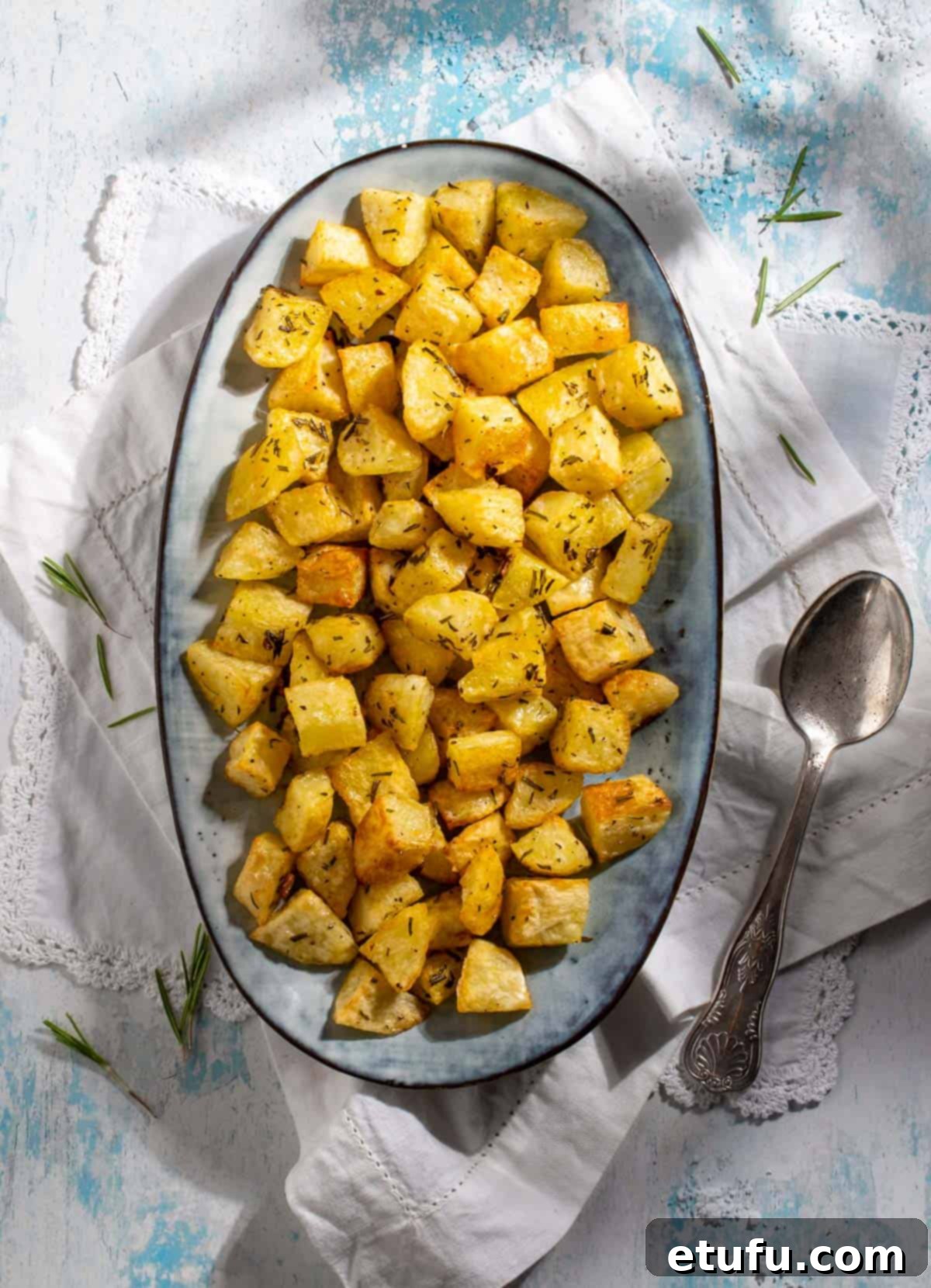
The Fascinating History: Why Are They Called Parmentier Potatoes?
The name “Parmentier Potatoes” is a direct homage to Antoine-Augustin Parmentier, an extraordinary French pharmacist, nutritionist, and agronomist. Born in the 18th century, Parmentier played a pivotal role in revolutionizing European diets by tirelessly championing the potato, a tuber brought from South America in the 1500s but largely shunned by the French populace.
Despite the potato’s initial resistance and widespread skepticism – partly due to its unfamiliar appearance and an unfounded belief that it caused leprosy – Parmentier recognized its immense nutritional potential. During a period of devastating famines in 18th-century France, he saw the potato not just as a food source, but as a solution to widespread hunger. His personal experience of consuming potatoes while imprisoned in Prussia during the Seven Years’ War convinced him of their value.
To overcome public prejudice and sway the skeptics, Parmentier employed ingenious and theatrical tactics. He hosted elaborate potato-themed banquets for high society, including King Louis XVI and Queen Marie Antoinette, showcasing the potato’s culinary versatility. Perhaps his most famous strategy involved planting heavily guarded potato fields just outside Paris. The guards were instructed to protect the fields during the day but to allow locals to “steal” the mysterious, supposedly valuable crops under the cover of night. This clever psychological ploy piqued public curiosity, leading them to believe the potatoes must be special if they required such protection.
These cunning tactics worked wonders. The “stolen” potatoes quickly found their way into French homes and, eventually, onto the French dinner table. What was once an alien and distrusted vegetable transformed into an essential component of French cuisine. Parmentier’s dedication and clever strategies successfully overcame centuries of doubt, permanently embedding the humble potato into the heart of France’s revered gastronomic tradition, forever linking his name to delicious potato dishes like these. His legacy lives on, a testament to his foresight and persistence.
Fast Facts – France: A Glimpse into the Land of Gastronomy
France, a country celebrated globally for its rich history, vibrant culture, and unparalleled culinary heritage, provides the perfect backdrop for our Parmentier Potatoes recipe. Here are a few quick facts about this remarkable nation:

| Location | France is strategically positioned in Western Europe, sharing borders with a diverse array of countries, including Belgium, Luxembourg, Germany, Switzerland, Italy, Spain, and Andorra. Its geographical diversity is further enhanced by extensive coastlines along the Mediterranean Sea to the south, the Atlantic Ocean to the west, and the English Channel to the north, offering a variety of landscapes and culinary influences. |
| Capital | The vibrant and iconic city of Paris serves as France’s capital. Renowned as the “City of Lights,” Paris is a global hub for art, fashion, gastronomy, and culture, attracting millions of visitors each year with its stunning landmarks and romantic ambiance. |
| Language | French is the official language of France, spoken by the vast majority of its population. It is also a significant global language, recognized as an official language in 29 countries and an important language of international diplomacy and culture. |
| Population | With a population of approximately 67 million people, France is one of the most populous countries in Europe. Its diverse population contributes to its rich cultural tapestry and vibrant society. |
| Trivia | An intriguing French superstition dictates that turning a baguette upside down invites bad luck. This belief likely stems from medieval times, when bakers would reserve the executioner’s bread by flipping it over. This practice associated inverted baguettes with death and misfortune, a superstition that has remarkably endured through the centuries, reflecting a deep respect for bread in French culture. |
What Makes This Parmentier Potatoes Recipe Irresistible?
There are countless reasons to fall in love with these French-inspired mini roast potatoes. Beyond their delicious taste, this recipe offers unparalleled convenience and impressive results:
- Effortless and Time-Saving: Prepare these exquisite potatoes in just 45 minutes, making them significantly faster and easier than traditional roast potatoes, perfect for busy weeknights or when you need a quick yet elegant side.
- Superior Crisp-to-Fluff Ratio: Thanks to the smaller potato cubes, you achieve an unparalleled balance of crispy exterior and wonderfully fluffy interior in every single bite. Each cube offers maximum textural delight.
- No Messy Oil Preheat Required: Skip the dangerous and often messy step of preheating oil in the oven. Our method starts with cold oil, making the preparation safer and simpler without compromising on crispiness.
- The Ultimate Versatile Side Dish: Whether it’s the star accompaniment for a grand Sunday roast, a festive holiday dinner, or a simple weeknight meal, these potatoes complement a wide array of main courses, enhancing any dining experience.
- A Guaranteed Crowd-Pleaser: These mini roast potatoes are universally loved. Their addictive crispness and fluffy texture mean they’re often the first dish to disappear from the table, ensuring leftovers are a rare occurrence!
- Infinitely Customizable: This recipe serves as a perfect canvas for your culinary creativity. Easily swap out herbs or introduce different spices to tailor the flavor profile precisely to your preferences, making it uniquely yours.
- Minimal Prep, Maximum Flavor: With straightforward preparation steps, this recipe frees up your valuable time to focus on other components of your meal, proving that extraordinary flavor doesn’t have to demand extensive effort.
Essential Ingredients for Perfect Parmentier Potatoes
The secret to exceptional Parmentier Potatoes lies in understanding your ingredients. While the recipe is straightforward, selecting the right components and knowing your substitution options can elevate your dish from good to extraordinary.
**Please refer to the detailed recipe card at the bottom of this post for the complete list of ingredients and precise measurements.

Potatoes: The Foundation of Flavor and Texture
The choice of potato is paramount for achieving that coveted crispy exterior and soft, fluffy interior. For the best roast potatoes, always opt for a starchy or all-purpose variety. Look for packaging that explicitly states they are ideal for roasting or making chips (fries), as these varieties are high in starch and lower in moisture, which contributes to the desirable texture.
For our friends in the UK: Maris Piper, King Edward, and Rooster potatoes are exceptional choices. Their floury texture ensures they become wonderfully fluffy inside while developing a perfect golden crust, and they readily absorb seasonings.
For those in America: Yukon Gold potatoes are an excellent option, known for their creamy texture and ability to roast beautifully. Russets (Burbank or Norkotah) are also a fantastic starchy choice for supreme crispiness.
And for Australians: Sebago and Desiree potatoes are reliable choices that will deliver excellent results for your Parmentier Potatoes.
Conversely, avoid waxy potato varieties such as new potatoes or red potatoes. These types have a higher moisture content and lower starch, making them better suited for boiling or salads, but they won’t achieve the desired crispness for roasting.
If you’re unsure about how to precisely cut your potatoes into perfect Parmentier cubes, we’ve provided a comprehensive visual guide further down in this article.
Vegetable Oil: The Crisping Agent
The type of oil you use is crucial for achieving a beautifully crispy result without any off-flavors. Apart from standard vegetable oil, any neutral-flavored oil with a high smoke point will work exceptionally well. Excellent choices include sunflower oil, canola oil, avocado oil, and corn oil. These oils can withstand the high temperatures required for roasting without breaking down or imparting undesirable tastes.
It is vital to avoid oils with a low smoke point. When subjected to high heat, these oils can quickly degrade, releasing unpleasant flavors and potentially harmful compounds. Oils to steer clear of for high-heat roasting include extra virgin olive oil (which is better for finishing dishes or lower-heat cooking), walnut oil, flaxseed oil, coconut oil, and butter. While butter adds flavor, its low smoke point causes it to burn easily at roasting temperatures.
Herbs: Aromatic Freshness
For this particular recipe, we’ve selected fresh rosemary, a classic choice that pairs wonderfully with potatoes, offering a piney, peppery aroma. However, the beauty of this dish lies in its adaptability. Feel empowered to customize it with your favorite fresh herbs. Consider incorporating fresh parsley for a bright, clean note, thyme for its earthy and slightly minty undertones, oregano for a robust Mediterranean twist, or basil for a sweet and peppery aroma, especially if you’re aiming for an Italian-inspired variation.
If fresh herbs are not readily available, dried herbs can serve as a convenient and flavorful alternative. While fresh herbs typically offer a more vibrant and nuanced flavor, dried herbs provide a concentrated and robust taste. Dried Italian seasoning, a blend often containing oregano, basil, thyme, and rosemary, is particularly harmonious with these potatoes, offering a well-rounded aromatic profile.
Garlic: The Essential Flavor Enhancer
When it comes to enhancing the flavor of roast potatoes, garlic is an indispensable partner. Its pungent, sweet, and aromatic qualities perfectly complement the earthiness of the potatoes. We typically recommend using three to four fresh garlic cloves, adjusting the quantity based on their size and your personal fondness for garlic. Aim for approximately one heaped tablespoon of finely chopped garlic to ensure a balanced yet noticeable garlic presence.
For those seeking convenience, or if fresh garlic is unavailable, garlic powder, garlic granules, or even onion powder can be used as suitable substitutes. While they offer a different textural experience, they will still contribute a delicious allium flavor to the dish.
Salt and Pepper: Seasoning to Perfection
Properly seasoning your potatoes is fundamental to bringing out their best flavor. The exact amount of salt and freshly ground black pepper can, of course, be adjusted to your personal preference. As a guiding principle for a robustly seasoned potato, we typically incorporate about one teaspoon of fine sea salt or kosher salt for that satisfying salty kick, which also aids in drawing out moisture for crisping. For pepper, we suggest half a teaspoon of freshly ground black pepper, which provides a fragrant warmth and subtle spice.
Always remember that seasoning is a personal journey; feel free to fine-tune these amounts to perfectly match your individual taste buds and ensure every bite is seasoned to your liking.
Precision Cutting: How to Cube Potatoes for Parmentier
Achieving the ideal size and shape for your potato cubes is key to perfect Parmentier Potatoes. While it might seem daunting, it’s simpler than you think. Let’s clarify a couple of crucial points before you begin slicing:
Firstly, the potato demonstrated in our visual guide below is of a medium-large size. If you’re working with smaller potatoes, you might need to make slight adjustments to the initial cuts, but the fundamental objective remains the same: to create cubes that are approximately 2cm x 2cm (which is just under one inch wide). Consistency in size is more important than absolute perfection in shape for even cooking.
Secondly, resist the urge to obsess over slicing perfectly symmetrical cubes. Seriously, once these golden, delicious roasties are served, no one will be conducting a geometry inspection. In fact, those charmingly rounded and slightly pointy bits that some overly fastidious chefs might discard are often the most coveted parts, crisping up beautifully and adding delightful textural variety!
Take another glance at our main feature photo at the very top of the page. You might notice that a few cubes are not perfectly square; some even resemble triangles. These are typically the end pieces of the potato. Does it detract from their appeal? Most likely, unless you possess an exceptionally meticulous eye, you probably didn’t even notice until we pointed it out. Embrace the rustic charm!
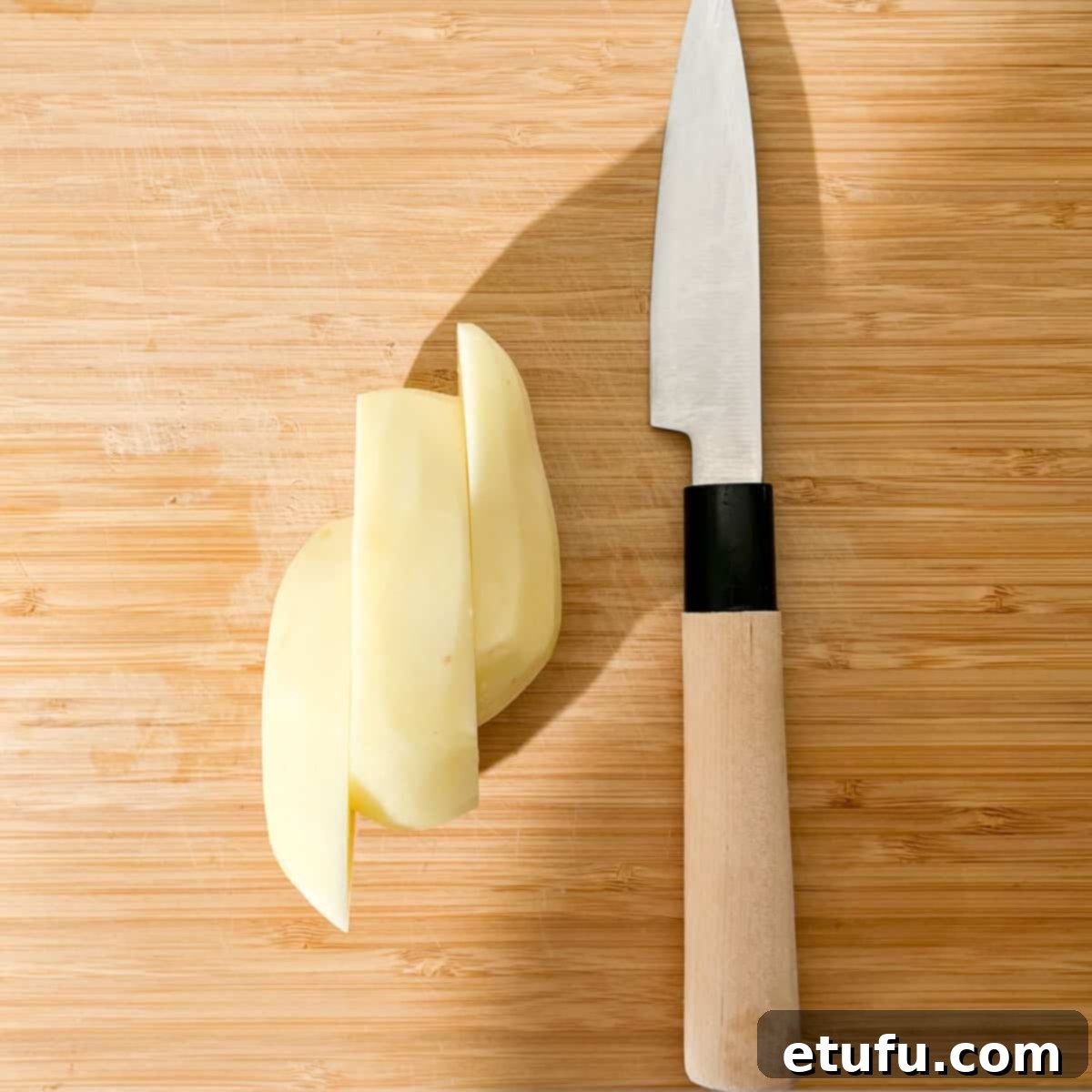
- Initial Slices: For a medium-large potato, begin by slicing it lengthwise into three uniform sections. Aim for each section to be roughly 2cm wide when observed from the top. If you are using a smaller potato, simply halving it lengthwise might suffice. Conversely, a very large potato may require four initial slices to maintain the desired thickness.
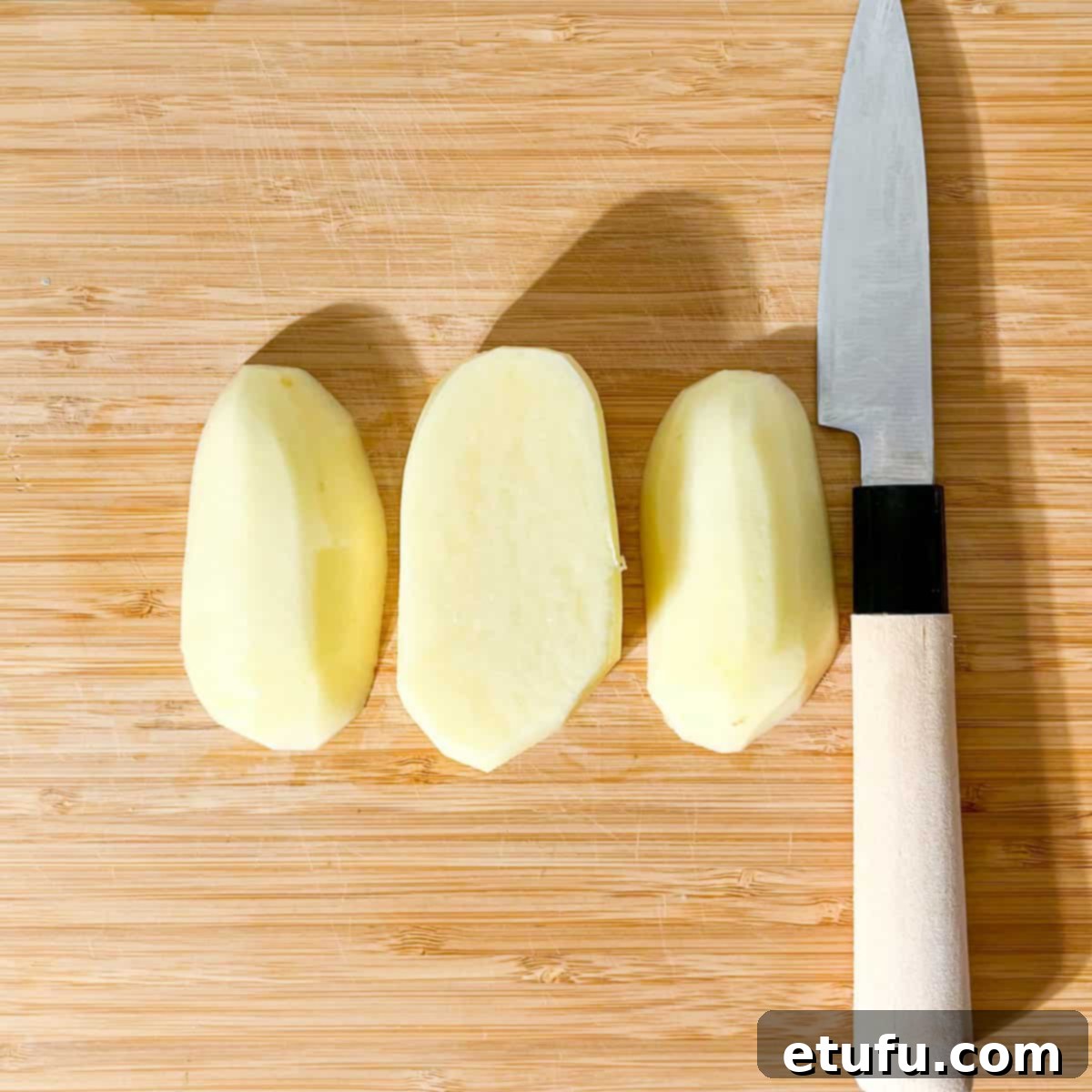
- Orient and Slice Again: Once you have your lengthwise sections, turn each of these thirds onto its side. This positions them perfectly for the next cut.
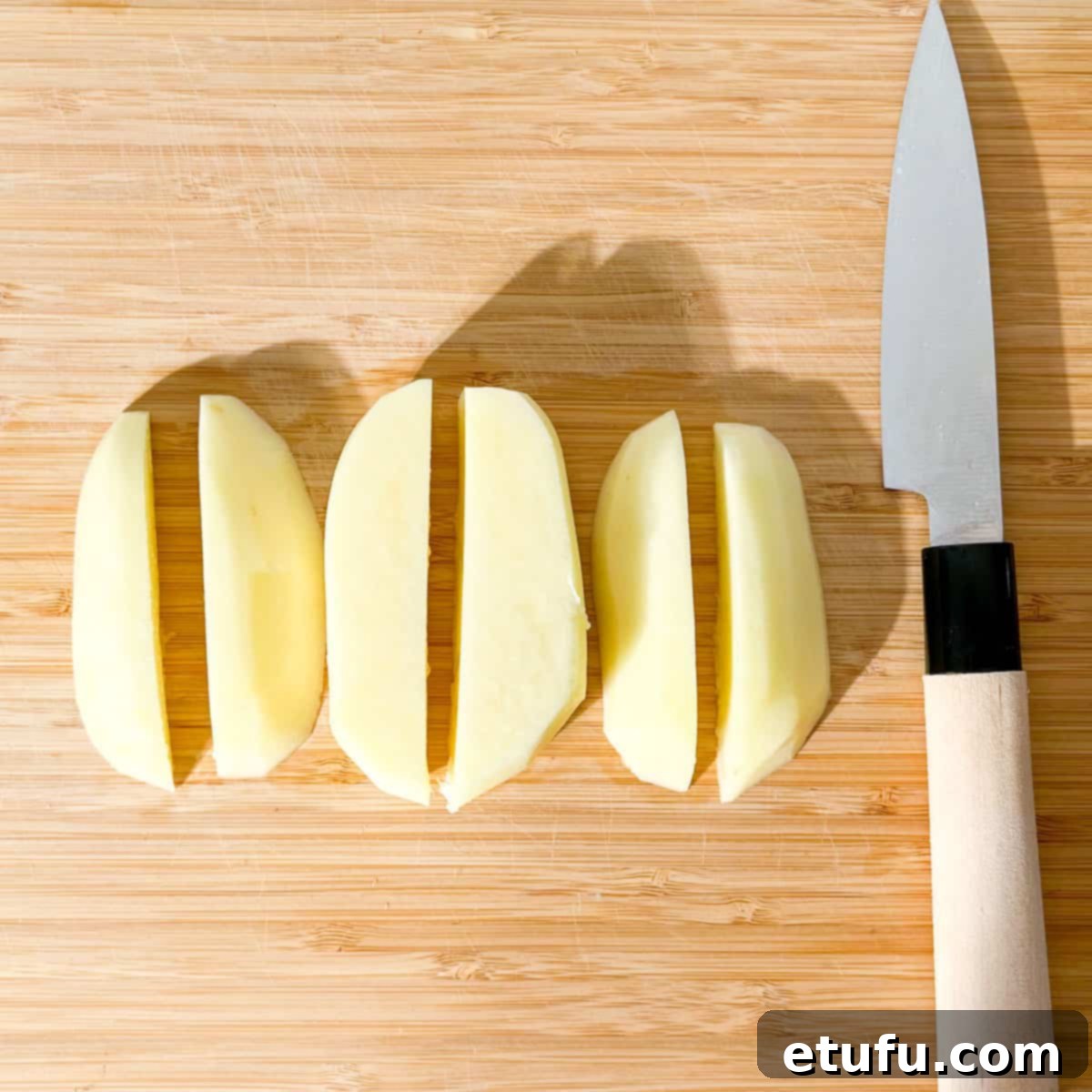
- Halve the Sections: Now, take each of the thirds you’ve turned on its side and slice it in half lengthwise again, ensuring you maintain that approximately 2cm width for each new strip. You should now have narrower strips of potato.
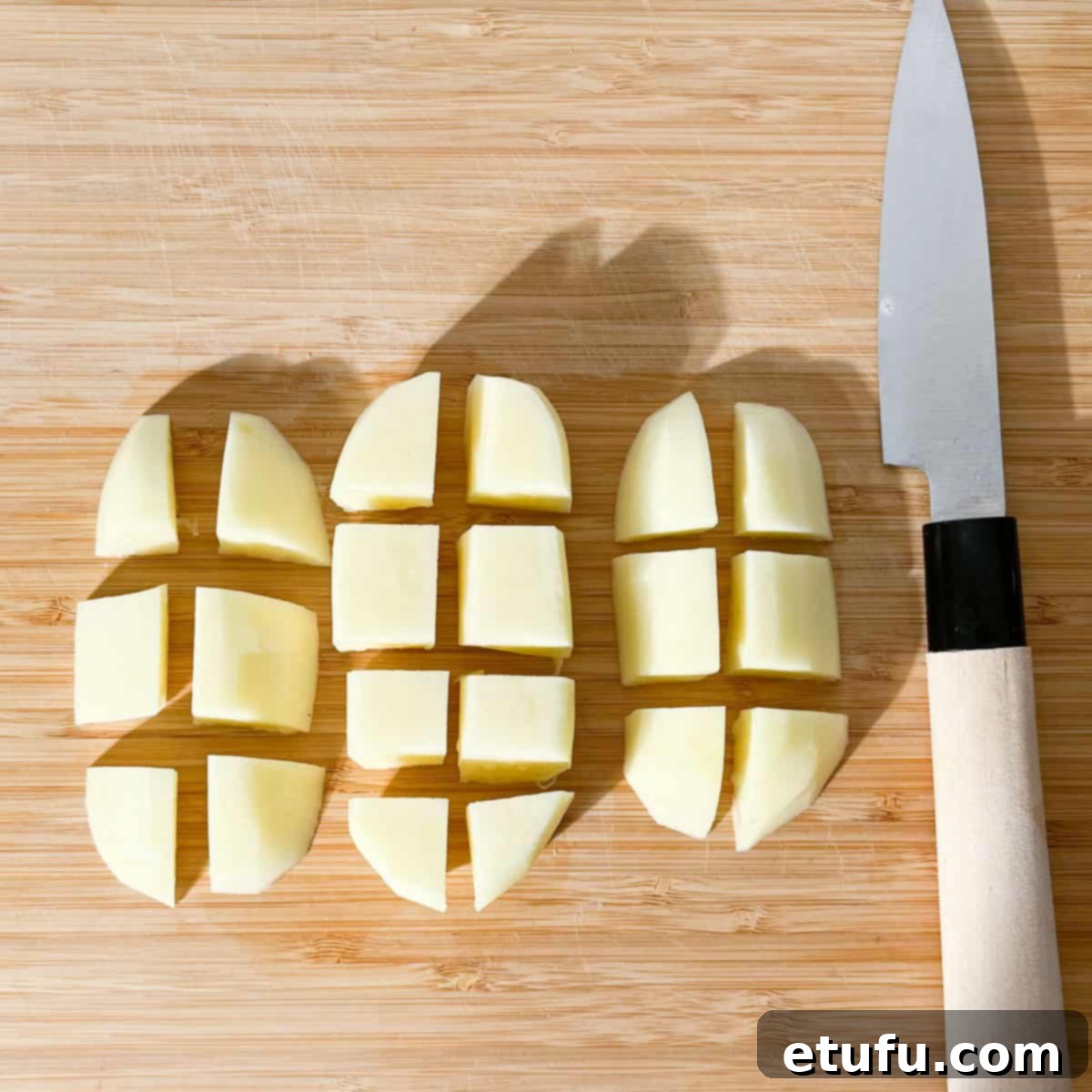
- Final Cubing: Finally, take these narrower strips and slice them crosswise into smaller, roughly 2cm pieces, effectively creating your potato cubes. You might find that the middle slices of the potato yield slightly longer pieces, allowing you to get a couple of extra cubes from each. And there you have it – perfectly sized potato cubes, ready for their transformation into delicious Parmentier Potatoes!
How to Make Delicious Parmentier Potatoes: A Step-by-Step Guide
Follow these precise steps to create the ultimate crispy and fluffy Parmentier Potatoes, a true taste of French culinary excellence:
- Prepare Your Oven: Begin by preheating your oven to 220°C/428°F/Gas Mark 7. This high temperature is crucial for achieving that desirable crisp exterior. While the oven heats, ensure you have a large, sturdy baking sheet ready.

- Chop Aromatics: Carefully strip the fragrant leaves from your fresh rosemary sprigs, discarding the woody stems. Finely chop the rosemary leaves. Next, peel and finely chop the garlic cloves. Set these aside; they will be added later to prevent burning.
- Cube Your Potatoes: Peel your chosen potatoes (or leave the skins on if you prefer a rustic touch, though peeling enhances crispness). Following our guide above, slice them into uniform cubes, aiming for roughly 2cm x 2cm in size. Consistency is key for even cooking.

- Cover with Cold Water: Place all the cubed potatoes into a large saucepan. Generously cover them with cold tap water, ensuring the potatoes are fully submerged. Starting with cold water allows the potatoes to cook more evenly from the outside in.
- Bring to a Boil: Place the saucepan on your stovetop over medium-high heat. Bring the water to a rolling boil. Keep a close eye on the pot to avoid overcooking.
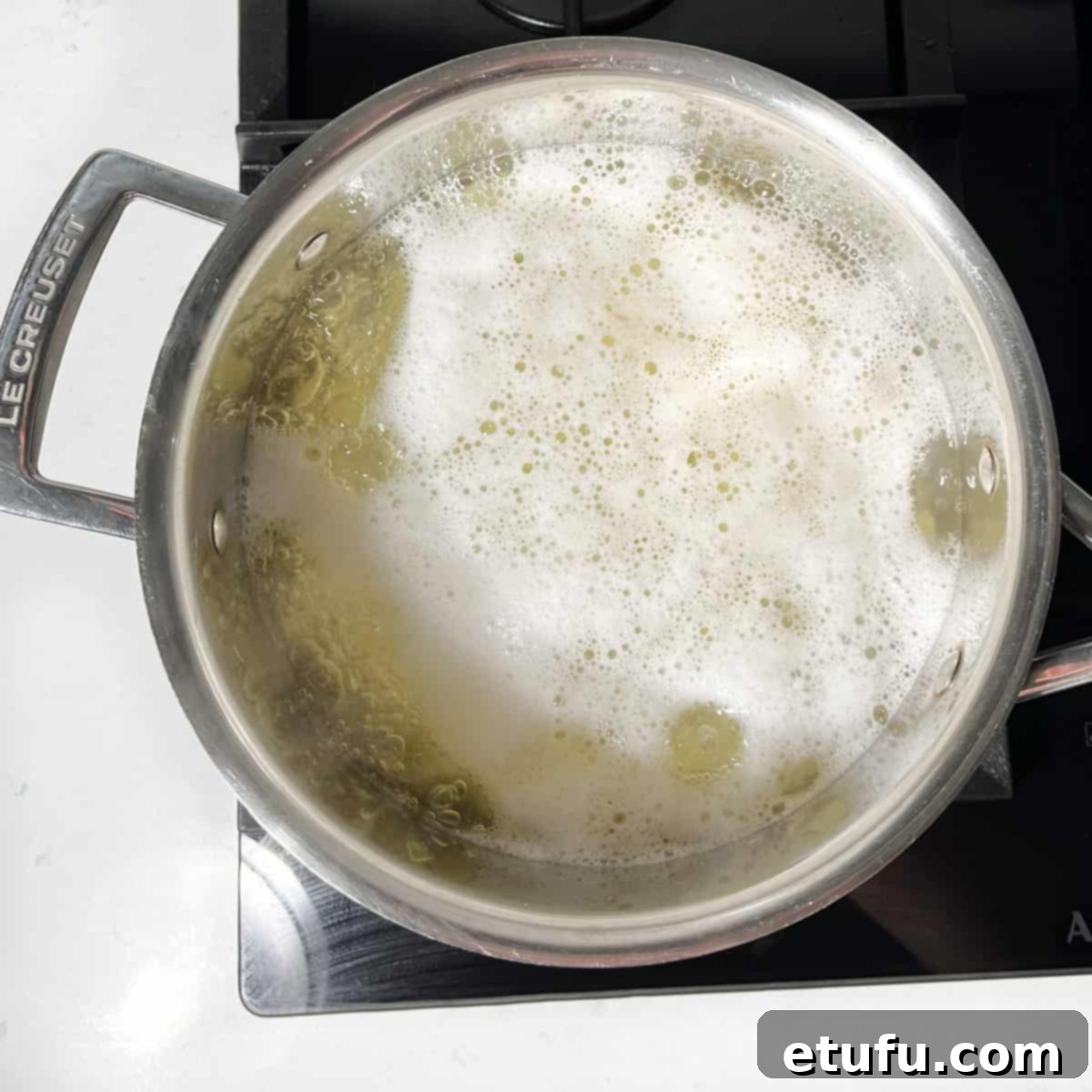
- Quick Parboil: The moment the potatoes reach a vigorous rolling boil, immediately remove the saucepan from the heat. Do not continue to boil them for any longer, as this will result in mushy potatoes. We’re only aiming for a quick parboil.
A rolling boil is characterized by large, continuous bubbles rapidly rising to the surface, indicating active, strong boiling, more vigorous than a gentle simmer.

- Drain and Steam-Dry: Carefully drain the potatoes thoroughly in a colander. Then, return the drained potatoes to the empty, hot saucepan. Allow them to steam-dry for approximately 5 minutes. This crucial step removes excess surface moisture, which is essential for achieving ultimate crispiness. Unlike traditional roast potatoes, do not shake the saucepan; this can damage the cube shape.

- Transfer to a Bowl: Once the potatoes have thoroughly steam-dried and appear visibly drier on the surface, transfer them carefully to a large mixing bowl.

- Season the Potatoes: Add the chosen vegetable oil, along with your measured salt and freshly ground black pepper, directly over the potatoes in the bowl.
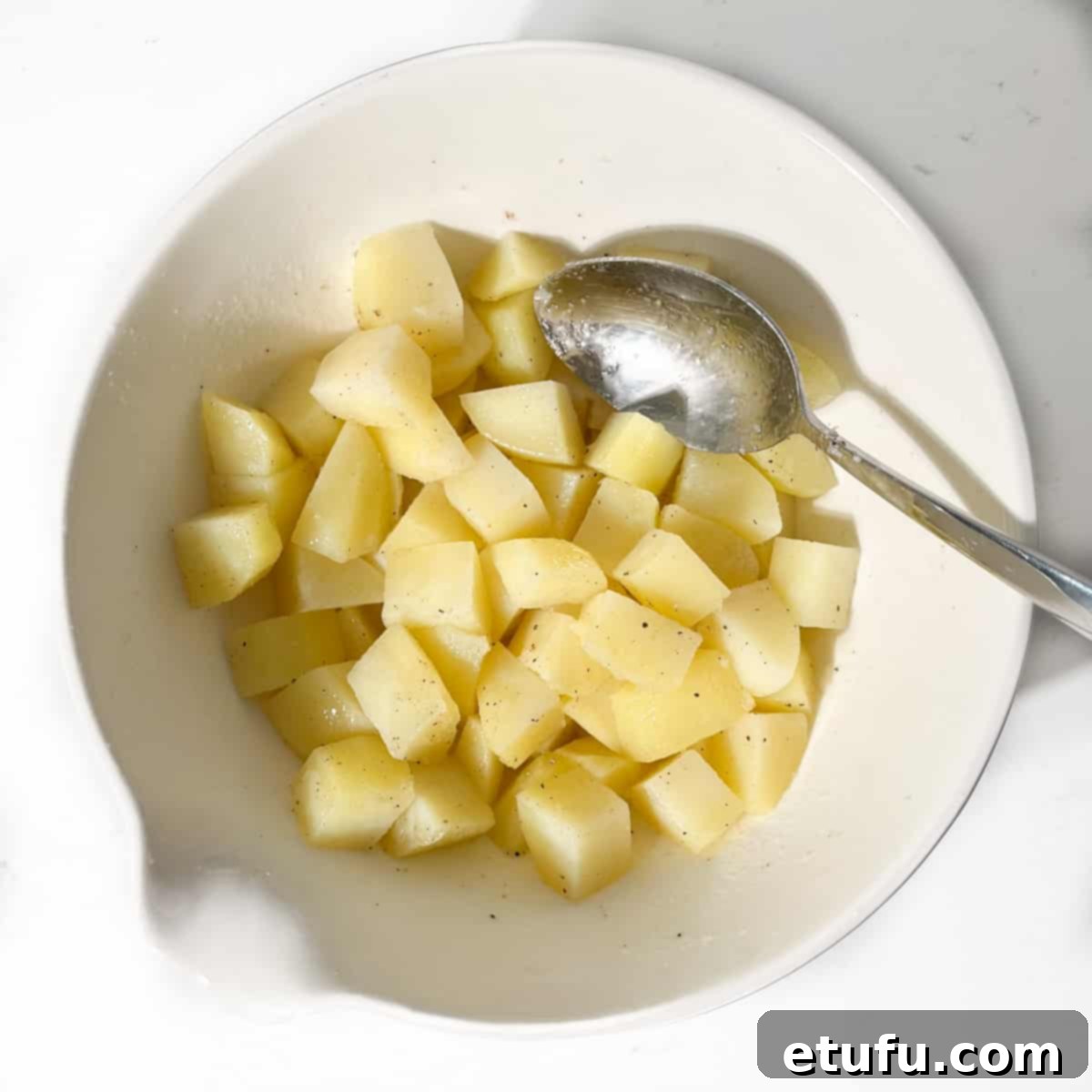
- Gently Coat: Using a large spoon or spatula, gently mix the oil and seasonings into the potatoes. Exercise care to avoid breaking the delicate parboiled cubes. Use a gentle up-and-over motion to scoop the oil from the bottom of the bowl and drizzle it back over the potatoes, ensuring each cube is thoroughly and evenly coated on all sides for maximum crisping and flavor distribution.
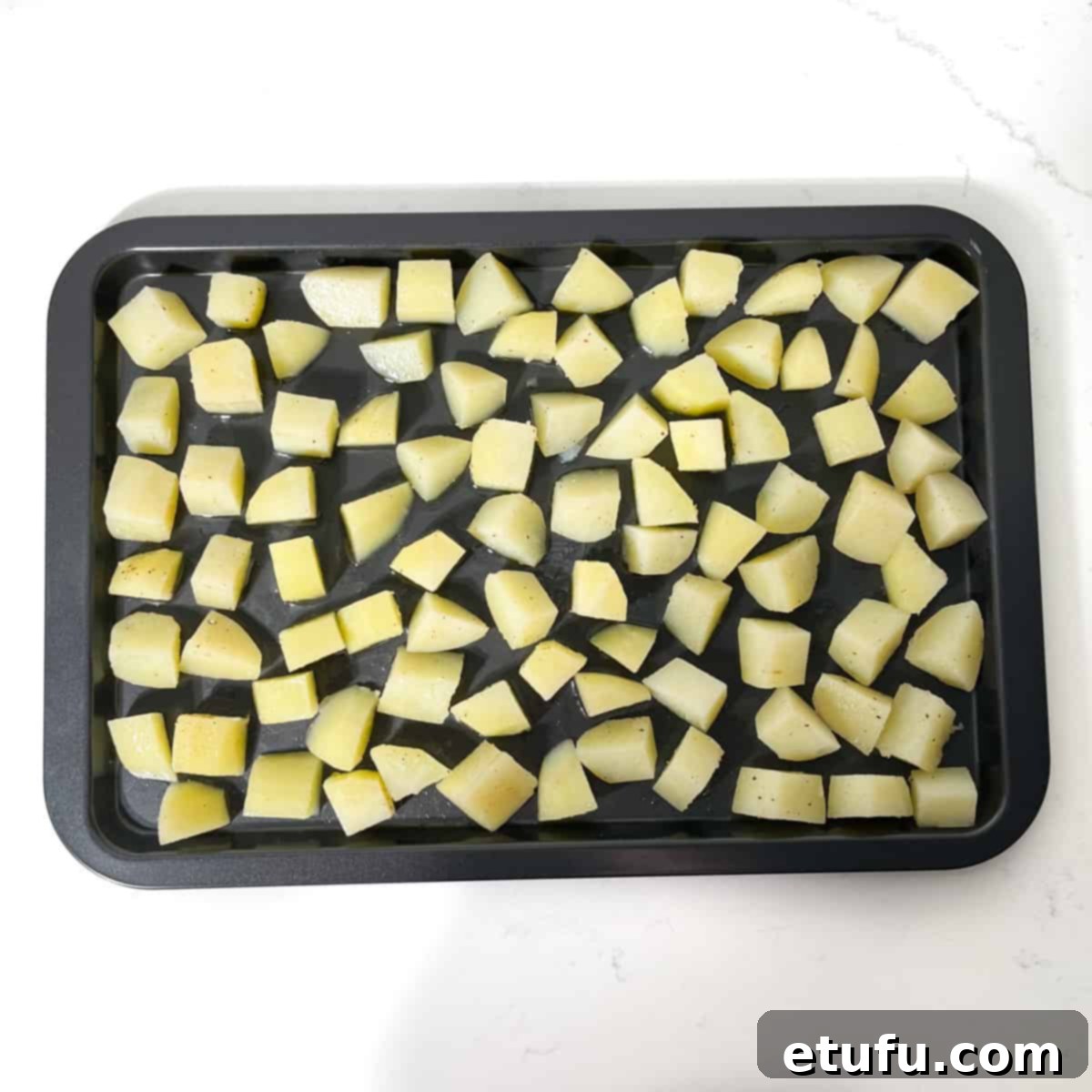
- Arrange on Baking Tray: Carefully tip the well-oiled potato cubes onto your prepared baking tray. Crucially, spread them out in a single layer, ensuring that each cube has ample space and is not touching its neighbors. This arrangement is vital for optimal air circulation and direct heat exposure, which are essential for superior roasting and crisping. If your tray is too small to accommodate a single layer, divide the potatoes between two trays.
- Initial Bake: Place the baking tray on the middle shelf of your preheated oven. Bake the potatoes for an initial period of 25 minutes. During this time, they will begin to develop a golden crust.

- Add Garlic and Herbs: After the initial 25 minutes, carefully remove the tray from the oven. Now, sprinkle the finely chopped garlic and fresh herbs evenly over the partially cooked potatoes. Using a spoon or spatula, gently toss and mix the potatoes to ensure the aromatics are well distributed and adhere to the cubes. This step also allows you to re-coat the potatoes in some of the residual oil, aiding further crisping.
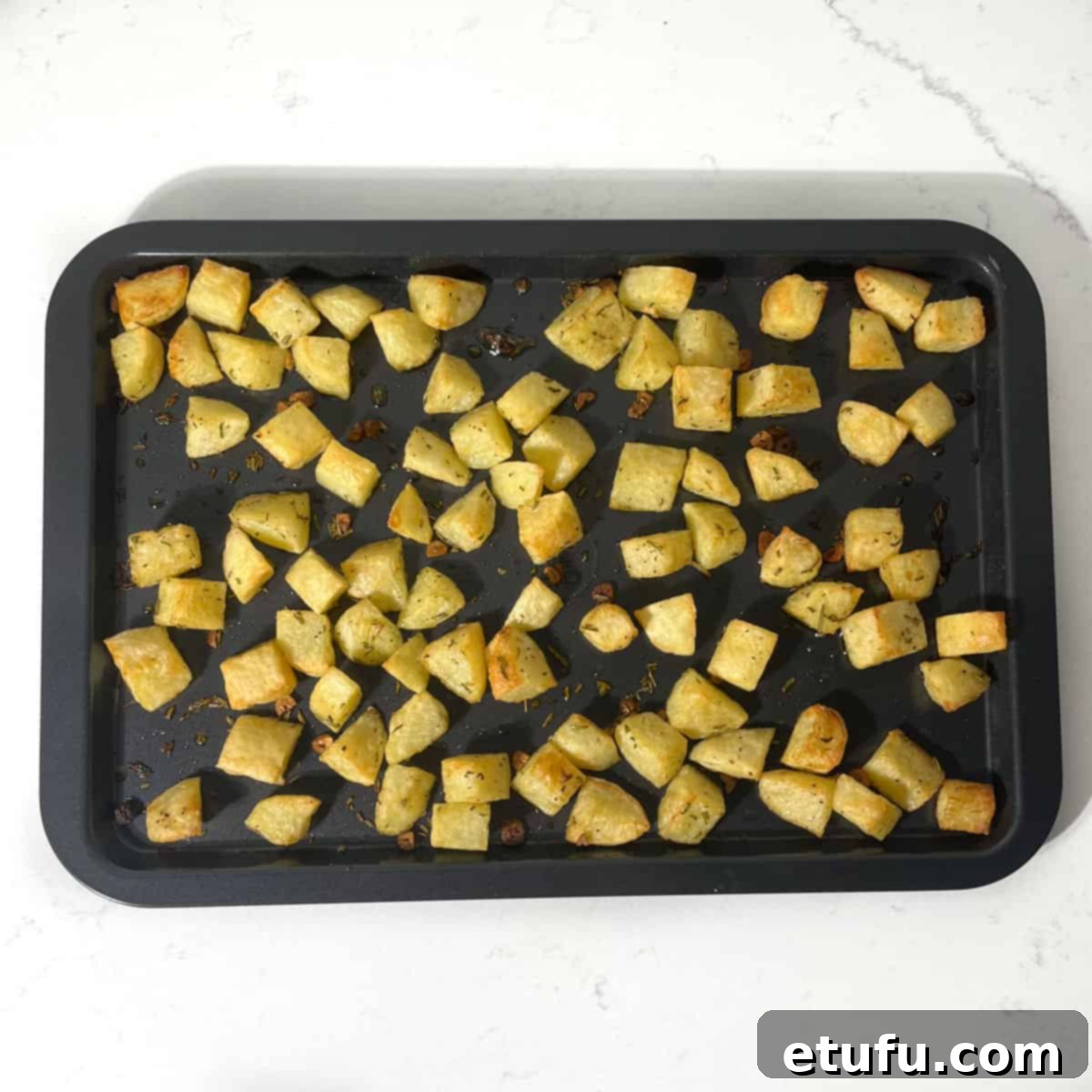
- Final Roast: Return the tray to the oven and continue baking for an additional 10-15 minutes. Keep a watchful eye, as cooking times can vary. Roast until the potatoes are beautifully crispy, intensely golden brown, and cooked to your desired level of perfection.
- Serve Immediately: Once roasted, transfer the glorious Parmentier Potatoes to a warm serving bowl. They are best enjoyed immediately, while they are at their peak crispness and warmth.
Expert Tips for Unforgettable Parmentier Potatoes
To ensure your Parmentier Potatoes reach their full potential of crispiness and flavor, keep these expert tips in mind:
Choose the Right Potato Variety
The foundation of exceptional roast potatoes lies in selecting the correct type of potato. Always opt for starchy, all-purpose varieties over waxy types such as new potatoes or red potatoes. Baking potatoes like Maris Piper (UK), Russets (US), and Yukon Gold (US/Canada) are ideal because they are naturally high in starch and low in moisture. This composition allows their dry, fluffy flesh to achieve that quintessential crispy exterior and soft, yielding interior when roasted at high temperatures. Waxy potatoes, on the other hand, tend to remain dense and will not crisp up as effectively.
Ensure Uniformity in Potato Cube Size
While absolute geometric perfection is unnecessary, it is crucial to cut your potato cubes to a roughly uniform size. Aim for pieces that are approximately the same dimensions. This consistency is vital because potato pieces of varying sizes will roast at different rates. Smaller cubes will inevitably overcook and become overly dark or dry before larger ones have a chance to finish cooking through and achieve their desired crispness. Achieving a similar size for all your cubes ensures that every single potato piece on the tray will reach that ideal crunchy exterior and fluffy center simultaneously, guaranteeing a perfectly cooked batch.
Resist the Urge to “Rough Up” the Cubes
Unlike traditional, larger roast potatoes that often benefit from being shaken in the pot to roughen their surfaces and create extra crispy bits, these petite Parmentier potato cubes do not require such treatment. Their small size inherently provides ample surface area for crisping when roasted. Shaking them vigorously after parboiling would risk damaging their neat cube shape and compromising their elegant presentation. A gentle toss to coat with oil is all that’s needed.
Spread Potatoes in a Single Layer for Optimal Roasting
One of the most critical steps for achieving truly crispy Parmentier Potatoes is to arrange the oiled potato cubes on the baking tray in a single layer, ensuring there is ample space between each piece. For the very best results, the cubes should not be touching. This careful spacing is essential as it allows for proper air circulation around each potato and ensures direct exposure to the oven’s high heat. Both factors are paramount for producing superior roasting, even browning, and ultimate crispness. If your baking tray is too small to accommodate all the potatoes in a single layer with sufficient spacing, it is highly recommended to divide them between two trays. The small amount of extra time invested in properly spacing the potatoes will undoubtedly pay off in perfectly golden, incredibly crispy Parmentier Potatoes.
Incorporate Garlic and Herbs Towards the End of Cooking
Fresh garlic and delicate herbs are incredibly flavorful but are also prone to burning quickly when exposed to high heat for prolonged periods. Do not be tempted to add them at the very beginning of the roasting process. If introduced too early, they will blacken and turn bitter, imparting an undesirable flavor to your delicious potatoes. Instead, incorporate the chopped garlic and herbs only during the final 10-15 minutes of roasting. This timing allows them to soften, release their potent aromas, and lightly crisp without burning, ensuring they enhance rather than detract from the dish’s flavor.
Delicious Variations: Customize Your Parmentier Potatoes
While classic Parmentier Potatoes are a delight on their own, this recipe is incredibly versatile and can be easily adapted to introduce new and exciting flavor dimensions. Get creative with these delicious variations:
- Parmesan Perfection: For a cheesy twist, toss the potato cubes generously in freshly grated Parmesan cheese before roasting. The cheese will melt and crisp, forming a delicious, savory crust.
- Smoked Paprika Depth: Dust the potatoes with smoked, sweet, or spicy paprika. Smoked paprika adds a deep, earthy warmth and a beautiful reddish hue, while sweet paprika offers a milder flavor, and spicy paprika brings a gentle kick.
- Harissa Heat: Coat the potatoes in a small amount of harissa paste for a vibrant, spicy North African flavor, or sprinkle with harissa powder for a drier application with a similar aromatic heat.
- Za’atar Zest: Sprinkle this aromatic Middle Eastern spice mix, typically containing thyme, sesame seeds, and sumac, over the potatoes for a tangy, herbaceous, and nutty flavor profile.
- Curry Powder Kick: Add a blend of your favorite curry spices to the cubes for an exotic and aromatic Indian-inspired side dish that pairs well with many mains.
- Chilli Powder Punch: For varying levels of heat and smoky notes, dust with ancho chilli powder (mild and smoky), chipotle powder (smoky and medium heat), or cayenne pepper (hot and fiery).
- Turmeric Earthiness: Incorporate ground turmeric for an earthy, slightly bitter flavor and a stunning golden-yellow color that also boasts health benefits.
- Cumin Warmth: A pinch of warm, earthy ground cumin beautifully complements the flavor of roasted potatoes, adding a subtle depth of flavor.
- Thyme Infusion: Substitute rosemary with chopped fresh or dried thyme leaves for a more delicate, earthy, and slightly minty aromatic profile that pairs wonderfully with root vegetables.
- Basil Brilliance: Use fresh basil, chopped and added towards the end of cooking, for a fragrant, sweet, and peppery Italian twist that brightens the flavor.
- Sweet Shallot Flavor: Add finely chopped shallot along with the garlic for a milder, sweeter, and more delicate onion flavor that caramelizes beautifully.
- Chorizo Delight: For a smoky, spicy, and savory depth, toss finely diced chorizo through the potatoes before baking. The chorizo fat will render and infuse the potatoes with incredible flavor.
- Red Chilli Flakes: A simple addition of red chilli flakes provides a touch of immediate heat, perfect for those who enjoy a bit of spice with their potatoes.
Creative Serving Suggestions for Parmentier Potatoes
Parmentier Potatoes are incredibly versatile and can elevate almost any meal. Their crispy texture and savory flavor make them an ideal companion to a wide range of dishes. Here are some creative serving suggestions:
- Classic Roasted Meats: Serve as a sophisticated side dish alongside traditional roasted meats such as succulent chicken, tender beef, flavorful lamb, or juicy pork. They are particularly exquisite with Sunday roasts and festive holiday dinners like Christmas, Easter, or Thanksgiving.
- Comforting Stews and Pies: Pair these crispy potatoes with hearty pot pies or rich stews. The contrast between the tender, saucy main course and the crispy potato cubes creates a delightful textural experience.
- Unique Pizza Topping: For an unexpected twist, scatter the Parmentier Potatoes over your pizza before baking. They add a delicious crunch and a satisfying carb element that will surprise and delight.
- Hearty Salad Component: Toss them into a robust main-course salad featuring mixed greens, hard-boiled eggs, and various meats for a filling and texturally interesting meal.
- Elegant Gratin Layer: Layer Parmentier Potatoes into a gratin dish with creamy sauces and your favorite cheeses for a decadent and comforting side that’s perfect for special occasions.
- Sautéed Accompaniment: Top the potatoes with vibrant sautéed peppers, onions, and slices of savory sausage for a complete and flavorful skillet meal.
- Breakfast Hash Base: Incorporate them into a breakfast hash with scrambled or fried eggs and other vegetables for a hearty and satisfying start to your day.
- Fish Pairing: Plate these golden cubes next to delicate fish dishes like flaky salmon, mild cod, or buttery halibut. The potatoes provide a satisfying counterpoint to the lightness of the fish.
- Dipping Delight: Serve them as a tasty appetizer or snack with an assortment of dips such as creamy aioli, spicy mustard, or classic ketchup for an informal yet delicious treat.
- Full English Breakfast: Add Parmentier Potatoes to a traditional breakfast plate alongside eggs, crispy bacon, and toast for an elevated and extra-special breakfast experience.
Storage and Reheating Best Practices
For the absolute best taste and texture, Parmentier Potatoes are truly at their peak when enjoyed fresh from the oven, still warm and wonderfully crispy. However, if you find yourself with a delicious surplus, any leftover Parmentier potatoes can be stored effectively to be savored later.
To store, simply transfer the cooled potatoes to an airtight container. They will keep beautifully in the refrigerator for up to 3 days. This allows for convenient meal planning or enjoying leftovers without significant quality loss.
When it comes to reheating, the oven is your best friend for reviving their signature crispness. Spread the refrigerated potatoes out evenly on a baking tray. Place them in a preheated oven at 200°C/392°F/Gas Mark 6 and bake for approximately 15-20 minutes, or until they are piping hot throughout and have regained their delightful crisp exterior. This oven method ensures they crisp up again rather than becoming soggy, bringing them close to their freshly baked glory.
Feel free to prepare a larger batch in advance and reheat them on the day you plan to serve. This strategy provides a quick and elegant side dish with minimal fuss when you need it.
Can You Freeze Parmentier Potatoes? Considerations for Freezing
While it is technically possible to freeze Parmentier potatoes, it’s important to manage expectations, as they may undergo some textural changes that make them slightly less ideal than when freshly prepared. Here are some key considerations:
- Loss of Crispness: The hallmark crispy exterior of Parmentier potatoes will inevitably soften when subjected to the freezing and thawing process. They will not retain their original crunch after being frozen.
- Textural Alterations: The fluffy interior, so delightful when fresh, can become slightly mealy or drier after freezing and reheating. The smooth, creamy texture might not be quite as pronounced.
- Diminished Flavor: Any delicate seasonings, especially fresh herbs and spices, can diminish in flavor intensity after being frozen. While still tasty, the vibrant notes might be subdued.
- “Freezer Taste”: Potatoes, like many starchy foods, can sometimes absorb a subtle “freezer taste,” which might alter their original flavor profile slightly.
- Waterlogging Risk: Condensation that forms during thawing can potentially make the potatoes somewhat waterlogged, further compromising their texture if not properly managed.
If you choose to freeze them, ensure they are completely cooled before transferring them to an airtight, freezer-safe container or bag. To reheat from frozen, spread the potatoes in a single layer on a baking tray and bake at 200°C/392°F/Gas Mark 6 for approximately 20-25 minutes, or until they are thoroughly heated and have regained some crispness. While not quite the same as fresh, they will still be a satisfying accompaniment.
Perfect Pairings: Recipes to Enjoy with Parmentier Potatoes
Parmentier Potatoes are a superb side dish that complements a wide array of main courses. Here are some excellent recipes that would be beautifully enhanced by these crispy, fluffy potatoes:
The Ultimate Crispy Roasted Potatoes (for comparison!)
Lihapullat – Finnish Meatballs
Trinchado – Portuguese-Inspired South African Beef Stew
Creamy Chicken and Leek Pies with Puff Pastry
Prego Steak Rolls (South African steak sandwiches)
Posh Fish Finger Sandwich with Homemade Tartar Sauce
Easy Green Pea Fritters
Crispy Fish Goujons
The Very Best Devilled Sausages
Tender Chicken Rissoles
Vibrant Red Chimichurri Sauce (Chimichurri Rojo)
Frequently Asked Questions About Parmentier Potatoes
While it’s not strictly mandatory, parboiling the potato cubes briefly is highly recommended. This step ensures the potatoes cook partially and evenly, which is key to achieving those wonderfully fluffy interiors while still allowing the exteriors to crisp up beautifully in the oven. It’s a small effort that yields significant rewards in texture.
No, peeling Parmentier potatoes is entirely a matter of personal preference. You can certainly leave the skins on for a more rustic appearance and added fiber. If you choose to leave the skins on, ensure you scrub the potatoes thoroughly before cutting and cooking.
Yes, canned potatoes can be used as a convenient shortcut for Parmentier potatoes. Since canned potatoes are already parboiled, you can completely skip the initial boiling step in the recipe. Simply drain them very well, pat them dry to remove excess moisture, and then proceed directly to covering them in oil and seasonings, following the remaining instructions as per the recipe.
Absolutely! This recipe is easily scalable. If you’re feeding a larger crowd or simply want more delicious Parmentier potatoes, just double all the ingredients. However, it’s crucial to ensure you use a large enough baking tray (or two separate trays) so that the potato cubes can still be spread out in a single layer without overcrowding. Overcrowding will steam the potatoes instead of roasting them, preventing them from crisping up properly.
More Festive Recipes for Your Holiday Table
Looking for more culinary inspiration, especially for the holiday season? Pair your Parmentier Potatoes with these delightful Christmas-themed recipes:
Elegant Frangipane Mince Pies
Christmas Picture Cookies with Edible Wafer Paper
Easy Traditional Christmas Cake
The Best Pigs in Blankets with a Whisky and Honey Glaze
Roasted Tenderstem Broccoli with Parmesan and Pine Nuts
Creamy Carrot and Swede Mash
The Best Honey-Roasted Carrots and Parsnips
Quick and Festive Cassata Ice Cream
Homemade Rum and Ginger Truffles
Sweet Thumbprint Icing Cookies (Hallongrottor)
Explore More Delicious Potato Recipes
If you’re a potato lover, be sure to check out these other fantastic potato-centric recipes for more inspiration:
The Ultimate Crispy Roast Potatoes (a different roasting method!)
Irresistible Loaded Potato Wedges with Chorizo and Avocado Sauce
Recipe: Classic Parmentier Potatoes

Parmentier Potatoes (Mini Roast Potatoes)
By roasting bite-sized potato cubes instead of larger spuds, you achieve superior crispness per bite in less roasting time. As the potatoes roast, the exterior moisture evaporates from the small cubes, leaving lots of crunchy edges contrasting the soft, steamy interiors.
Print Recipe
Save
Ingredients
- 1 kilogram potatoes – like Maris Piper, Kind Edward, Rooster, Yukon Gold, Desiree
- 4 tablespoons vegetable oil – or any plain oil with a high smoking point like sunflower or canola
- 3-4 garlic cloves – chopped (about one heaped tablespoon)
- 3-4 sprigs rosemary – leaves stripped (about one heaped tablespoon chopped)
- salt and pepper to taste – as a guide, we add one teaspoon salt and half a teaspoon pepper
Instructions
- Preheat the oven to 220°C/428°F/Gas Mark 7. Have a large baking tray ready.
- Strip the leaves from the rosemary sprigs and finely chop the rosemary. Peel and chop the garlic.3-4 garlic cloves, 3-4 sprigs rosemary
- Peel and then slice the potatoes into cubes of roughly 2cm x 2cm.
Refer to the detailed guide in the main blog post on how to slice cubes for Parmentier potatoes.
1 kilogram potatoes - Place the potatoes in a large saucepan and cover them with cold tap water.
- Place the saucepan on the stove over medium-high heat.
- Once the potatoes reach a rolling boil, immediately remove them from the heat. Do not boil them for longer than a brief parboil.
A rolling boil is characterized by large, continuous bubbles rapidly rising to the surface, more vigorous than a gentle simmer.
- Drain the potatoes thoroughly in a colander. Then return them to the saucepan and leave to steam-dry for about 5 minutes. Do not shake them as you might for traditional roast potatoes, to preserve their shape.
- Once the potatoes are dry, transfer them to a large bowl.
- Add the vegetable oil, salt, and black pepper to the potatoes.4 tablespoons vegetable oil, salt and pepper to taste
- Gently mix the oil and seasoning into the potatoes using a large spoon. Take care to coat each cube thoroughly on all sides with a gentle up-and-over motion to spoon oil from the bottom of the bowl back onto the potatoes.
- Tip the well-oiled potato cubes onto the baking tray. Spread them out in a single layer without touching for optimal roasting and crisping.
- Bake them on the middle oven shelf for an initial 25 minutes.
- After 25 minutes, remove the tray and mix in the chopped garlic and herbs. Ensure the potatoes are evenly re-distributed after mixing.
Mixing the potatoes thoroughly with the herbs and garlic will also allow you to re-coat them in some of the residual oil.
- Return to the oven and bake for 10-15 minutes more until the potatoes are crispy and golden brown to your liking.
- Transfer the potatoes to a serving bowl and enjoy immediately for the best crispness and flavor.
Notes
Potato Selection
Use starchy, all-purpose potatoes (e.g., Maris Piper, Russets, Yukon Gold) for fluffy interiors and crisp exteriors. Avoid waxy potatoes.
Uniform Cube Size
Cut potatoes to a consistent 2cm x 2cm size for even cooking. Small variations are fine, but aim for similarity.
Gentle Handling
Do not shake or rough up the parboiled potato cubes; their small size ensures crispness without damaging their shape.
Single Layer Roasting
Spread potatoes in a single layer on the baking tray with space between them to allow proper air circulation and maximum crisping. Use multiple trays if necessary.
Timing for Aromatics
Add fresh garlic and herbs only during the last 10-15 minutes of roasting to prevent them from burning and turning bitter.
**Nutritional Data Disclaimer**
Please keep in mind that the nutritional information provided below is calculated by a third party and we cannot guarantee its absolute accuracy. We strive to offer the most precise information possible, but we do not take responsibility for any potential errors. Furthermore, the nutritional value of this recipe may fluctuate depending on the exact brands and products used for your ingredients. We highly recommend consulting with a qualified healthcare professional or a registered dietitian for personalized advice regarding your specific dietary needs and requirements.
Nutrition
For important food safety advice, including comprehensive guidance on managing food allergies, please consult the Food Standards Agency.
